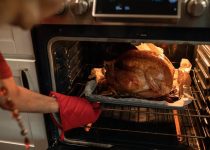How Long Does It Take to Cook a Ham on a Rotisserie
You know that feeling when you come across a perfectly cooked ham, with its succulent aroma and tender, juicy texture that makes your taste buds do a little happy dance?
It's like a culinary masterpiece in your backyard.
So, here's the thing: when it comes to cooking a ham on a rotisserie, the time it takes can be the difference between a delectable treat and a dry, overcooked disappointment.
But fear not, because finding that sweet spot is simpler than you think.
With a few key tips and tricks, you'll soon be mastering the art of rotisserie ham cooking, and that first delightful bite will make it all worth it.
Choosing the Right Size Ham
When choosing the right size ham for your rotisserie, consider the number of servings you'll need and the size of your rotisserie spit. Calculating the weight of the ham is crucial. A good rule of thumb is to estimate about 0.5 pounds (0.23 kg) of bone-in ham per person and 0.3 pounds (0.14 kg) of boneless ham per person. So, if you're expecting 10 guests, a 5-pound (2.27 kg) bone-in ham or a 3-pound (1.36 kg) boneless ham should suffice.
The cooking method you plan to use also influences the ham size. For rotisserie cooking, it's essential to ensure that the ham fits securely on the spit. If the ham is too large, it may not cook evenly or fit properly, which can affect the overall taste and texture. Additionally, a ham that's too small might leave your guests wanting more.
When in doubt, it's always better to err on the side of caution and go for a slightly larger ham. Leftover ham never goes to waste, and you can use it for sandwiches, omelets, or salads. Remember, the key to a successful rotisserie ham is choosing the right size for your specific rotisserie and the number of guests you'll be serving.
Preparing the Rotisserie and Ham
To prepare your rotisserie and ham, ensure that the rotisserie spit is securely attached and properly balanced before placing the ham on it. Start by setting up your rotisserie according to the manufacturer's instructions. Make sure the spit is inserted securely into the rotisserie and that it's properly balanced to avoid any wobbling or uneven cooking.
Once the rotisserie is set up, it's time to prepare the ham. Before seasoning the ham, trim any excess fat, leaving a thin layer to enhance flavor and juiciness. Then, apply your favorite ham seasoning, such as a glaze or dry rub, ensuring it's evenly coated for maximum flavor. Consider using a flavor injector to add extra moisture and taste to the ham as it rotates on the rotisserie.
Once the ham is seasoned to your liking, carefully place it onto the rotisserie spit, ensuring it's centered and secure. Now you're ready to cook your ham to perfection on the rotisserie, delivering juicy and flavorful results that will surely impress your guests.
Setting the Ideal Cooking Temperature
Hey there! Now that your rotisserie is all set up and your ham is ready to go, let's talk about setting the ideal cooking temperature.
Finding the right temperature range for your ham is crucial for achieving that perfect juicy and tender result.
We'll also cover the recommended cooking time to ensure your ham is cooked to perfection.
Ideal Temperature Range
Wondering what the ideal temperature range is for cooking a ham on a rotisserie? Let's find out the perfect setting for achieving succulent and flavorful results. When cooking a ham on a rotisserie, the ideal temperature range is between 250°F and 275°F (121°C to 135°C). This gentle heat allows the ham to cook evenly, ensuring optimal tenderness and flavor infusion. Cooking at a higher temperature may result in a drier and less flavorful ham, while a lower temperature might not effectively render the fat, leading to a less succulent outcome. Maintaining a consistent temperature within this range throughout the cooking process is key to achieving a juicy and delicious ham that will impress your guests. Check out the table below for a quick reference guide to the ideal temperature range for cooking a ham on a rotisserie.
| Temperature (°F) | Temperature (°C) |
|---|---|
| 250 | 121 |
| 275 | 135 |
Rotisserie Cooking Time
Maintaining a consistent temperature within the ideal range of 250°F to 275°F is crucial when it comes to setting the perfect cooking temperature for rotisserie ham, as it ensures even cooking and optimal tenderness.
When preparing your ham for rotisserie cooking, consider using a variety of seasoning options to enhance the flavor. Whether it's a classic combination of brown sugar and mustard or a blend of herbs and spices, the seasoning won't only add depth but also create a delicious crust.
To further elevate the taste, consider injecting the ham with a flavorful marinade to allow for a rotisserie flavor infusion. This can be done using a marinade injector, ensuring the flavors penetrate the meat, resulting in a more succulent and flavorful ham.
Calculating the Cooking Time
Alright, now let's talk about calculating the cooking time for your ham on the rotisserie.
The general rule is to allow 20 minutes of cooking time per pound of ham.
You'll also want to keep a close eye on the temperature to ensure it stays consistent throughout the cooking process.
Time per Pound
When determining the cooking time for your rotisserie ham, calculate approximately 20 minutes per pound, ensuring it reaches an internal temperature of 145°F. This ensures that your ham isn't only thoroughly cooked but also remains juicy and flavorful.
Here are some key points to remember when calculating the cooking time for your rotisserie ham:
- Allow the ham to rest for 10-15 minutes after cooking to let the juices redistribute, resulting in a more succulent and tender meat.
- Consider using different wood chips or herbs to infuse your ham with unique and delightful flavors, such as applewood for a subtle sweetness or rosemary for a fragrant touch.
- Regularly check the rotisserie for any signs of wear and tear, and clean it after each use to maintain its performance and longevity.
- In case of any issues, refer to the user manual for troubleshooting tips or contact the manufacturer for assistance.
Temperature Control
To ensure your rotisserie ham cooks to perfection, calculate the cooking time based on an approximate 20 minutes per pound, while also monitoring the internal temperature to reach 145°F for a deliciously juicy result.
Proper basting is essential to keep the ham succulent and flavorful throughout the cooking process. Every 30 minutes, use the natural juices or a basting sauce to ensure the ham stays moist and develops a flavorful crust.
Additionally, regular rotisserie maintenance is crucial for consistent and accurate cooking. Clean the rotisserie thoroughly after each use to prevent any buildup that could affect the heat distribution. Check the rotisserie's temperature controls and ensure they're functioning correctly to maintain a steady cooking environment.
Monitoring the Ham's Progress
As you monitor the ham's progress on the rotisserie, keep a close eye on the internal temperature to ensure it reaches the desired level of doneness. This is crucial for achieving that perfect balance of ham tenderness and flavor infusion.
Here are a few tips to help you master the art of monitoring your ham's progress:
- Use a reliable meat thermometer to check the internal temperature of the ham regularly. This will ensure that it's cooking evenly and thoroughly, without overdoing it.
- Keep an eye on the color and texture of the ham's surface. It should develop a beautiful golden-brown crust while maintaining its juiciness inside.
- Baste the ham with your chosen glaze or marinade throughout the cooking process. This not only enhances the flavor but also helps in keeping the ham moist and succulent.
- Trust your instincts and experience. Cooking a ham on a rotisserie is as much an art as it's a science. Pay attention to the aroma and overall appearance, and don't be afraid to make small adjustments as needed.
Resting and Serving the Rotisserie Ham
After the rotisserie ham has finished cooking, allow it to rest for 10-15 minutes before carving to ensure juiciness and easier slicing. This resting period allows the juices to redistribute, resulting in a more flavorful and tender ham.
When it comes to carving, start by placing the ham on a cutting board with a well to catch any juices. Use a sharp carving knife to make thin, even slices against the grain for the most tender texture. For an appealing presentation, arrange the slices on a serving platter and garnish with fresh herbs or fruit for a pop of color.
As for leftovers, any uneaten ham can be used in a variety of delicious recipes. To store, wrap the leftover ham tightly in plastic wrap or aluminum foil and refrigerate it promptly. It can be kept in the refrigerator for 3-4 days. You can also freeze the ham for longer storage, up to 2-3 months.
When you're ready to use the leftovers, consider adding them to omelets, salads, or sandwiches for a tasty meal. The versatility of leftover ham makes it a valuable addition to your culinary repertoire.
Frequently Asked Questions
Can I Use a Bone-In or Boneless Ham on a Rotisserie?
You can use a bone-in or boneless ham on a rotisserie. Bone-in hams may take a bit longer to cook, but both types produce juicy and flavorful results. Experiment to find your perfect cooking time.
Can I Use a Pre-Cooked or Uncooked Ham on a Rotisserie?
You can use a pre-cooked or uncooked ham on a rotisserie. The benefits of using a rotisserie for cooking ham include even cooking, juicy meat, and delicious flavor. It's a great way to elevate your ham.
Should I Use a Marinade or Seasoning on the Ham Before Cooking It on the Rotisserie?
When deciding between a marinade vs seasoning for your ham on the rotisserie, consider your flavor preferences. If you enjoy bold, complex flavors, a marinade might be best. For a simpler, more natural taste, stick with seasoning.
Can I Use a Glaze on the Ham While It's Cooking on the Rotisserie?
Yes, you can definitely use a glaze on the ham while it's cooking on the rotisserie. This will not only add flavor but also create a delicious caramelized crust through regular basting.
Can I Cook Other Foods Alongside the Ham on the Rotisserie?
Yes, you can cook other foods alongside the ham on the rotisserie. Just ensure cooking temperatures are appropriate for each item to ensure food safety. It's a great way to make the most of your rotisserie!



